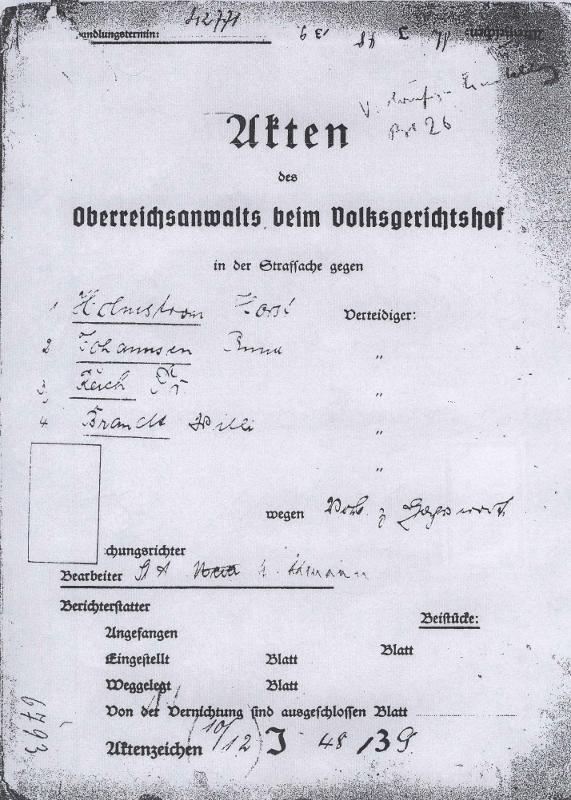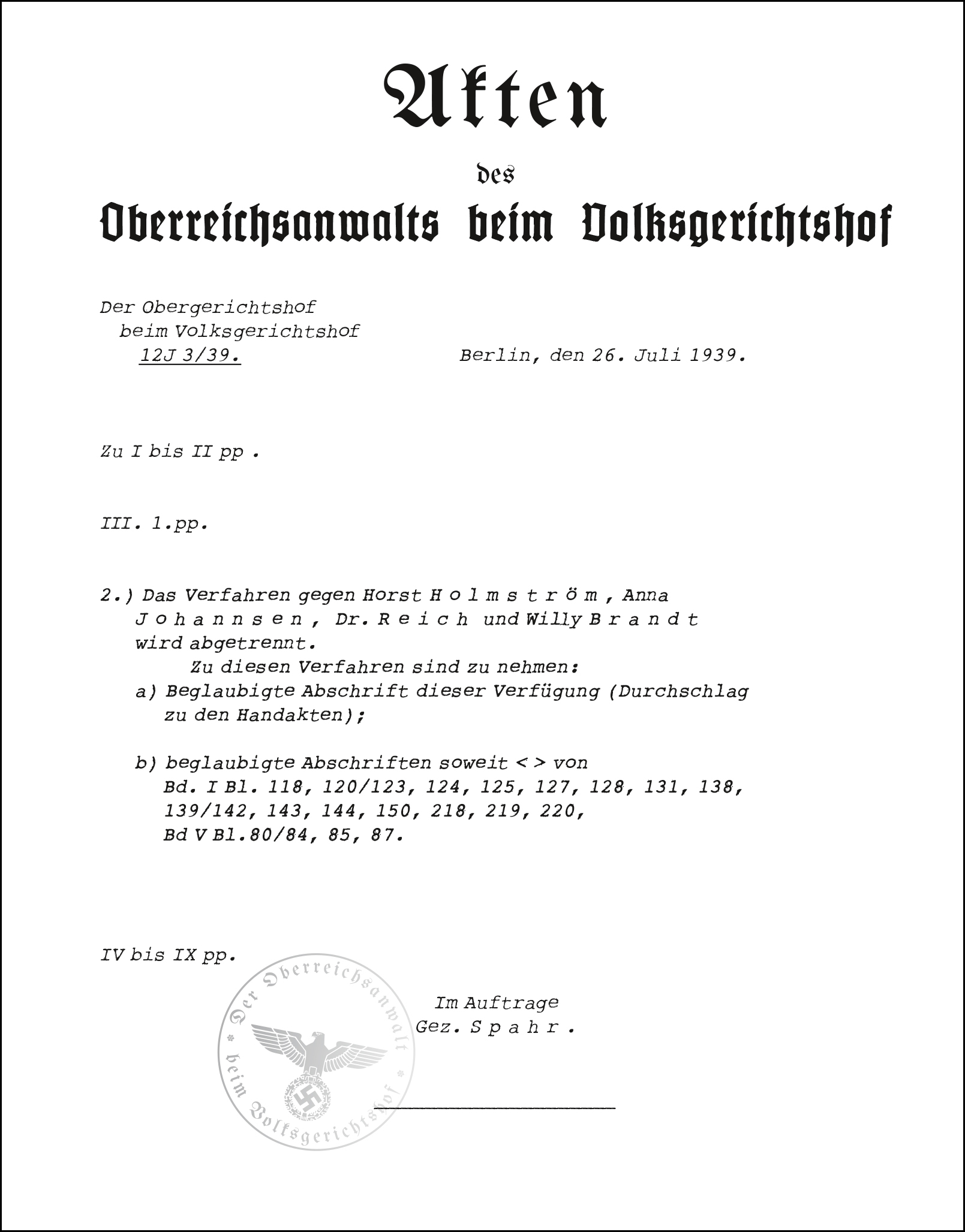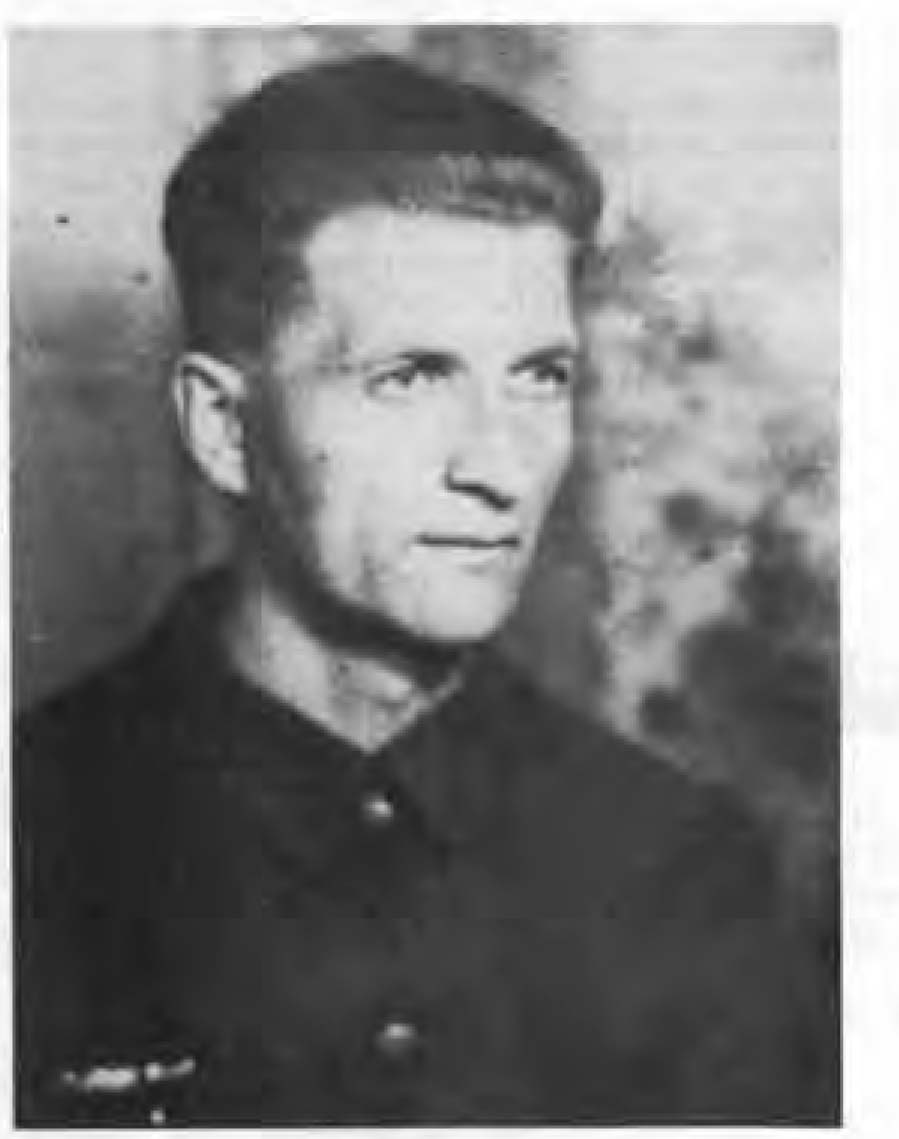by Andreas Peglau[1]
Announcement of an astonishing find: the psychoanalyst Reich and the later German Chancellor Willy Brandt were jointly targeted by the Nazi People’s Court for high treason in 1939. The role, perhaps decisive for Reich’s survival, of a hitherto unjustly unknown person is also revealed: Martin Mayer.
*
In 1939, the then 42-year-old Austrian psychoanalyst and former KPD member Wilhelm Reich faced the next and final stage of his exile odyssey. In March 1933 he had fled from Berlin to Vienna, from there to Denmark, Sweden, and finally Norway. Since the fall of 1938, he had been trying to get permission to leave for the USA.
While he was waiting for the necessary permits, two processes concerning him were going on in Germany, of which he was not aware. First, in the spring of 1938, shortly after the Anschluss of Austria, expatriation proceedings were initiated against him. [2] On the other hand, the Bremen judiciary was searching for him. [3] The background to this was Reich’s acquaintance with the later German Chancellor, Willy Brandt.
Jacob Walcher, functionary of the Socialist Workers‘ Party of Germany (SAP) had already sent the young SAP comrade Herbert Frahm, who adopted the fighting name Willy Brandt, to Norway in 1933 to form a political cell. Brandt’s life partner at the time, Gertrud Gaasland (actually Gertrud Meyer), in turn, was Reich’s secretary in Scandinavia – and until 1941 also in the USA – and played an important role for him. Gassland biographer Gertrud Lenz summarizes this thus:
„As a functionary of the SAP with leadership duties at the Oslo base, her functions in the youth organizations of the Norwegian labor movement, with close contact to the SAP foreign headquarters in Paris, to Willy Brandt, and to high-ranking functionaries of the Norwegian labor and youth movement, Gertrud Meyer was an important support for Wilhelm Reich in the sex-pol work, not only because of her professional qualifications, but also because of her party-political connections. Conversely, Reich’s connections were useful for the SAP party leadership, not least for Willy Brandt personally. Reich’s contacts in the left socialist network, the Zeitschrift für Politische Psychologie und Sexualökonomie he edited as an opinion leader in the left Freudian and left socialist milieu, and his financial contributions to the political organizations helped relieve the SAP’s financial situation.“ [4]
Such close contact also developed between Willy Brandt and Reich, [5] after all, that the latter informed Reich in detail on several occasions about his experiences as a participant in the Spanish Civil War. In Reich’s Zeitschrift für Politische Psychologie und Sexualökonomie (No. 3, 1937, pp. 207-214), an „eyewitness report“ from Spain, apparently written by Brandt but reproduced anonymously there, was published. [6] This begins: „It is damned difficult to remain an optimist under the conditions here,“ lamenting both the further political „right-wing“ developments in Spain, but also „the fray of forces in the anti-fascist camp.“
On 16.4.1937 Brandt wrote Reich a letter of more than six pages from Spain. [7] Returning from there, Willy Brandt took part in a secret conference of the SAP in southern Sweden between August 16 and 21, 1937. [8] Wilhelm Reich was also invited to this on Brandt’s initiative. [9] At this conference, emigrated SAP members and those working illegally in Germany met.
Brandt gave a paper on „Youth Issues and Party Organization.“ Reich organized the last day of the meeting. The minutes of the conference state:
„On the sixth day, the participants of the meeting met for a working session with Comrade W. Reich, who had appeared for this purpose, where the question of the sexual distress of German youth was dealt with.“ [10]
This topic fitted in well insofar as youth issues were in the center anyway, psychological aspects had previously been pointed out by various speakers, at one point also the increasingly prominent „sexual question“. From Bremen the 23-year-old Martin Meyer had come to the meeting, who was in charge of the youth work of the SAP. Meyer and Reich seem to have met there. [11]
Martin Meyer then continued his work in Germany against the Nazi regime – which included passing on „leftist“ literature. This led to his arrest in 1938, along with others from his circle. Meyer does not seem to have made any usable statements at first, despite several interrogations. [12]
In early 1939, however, apparently co-defendants informed the investigating authorities that Meyer had met both a „Willi Brandt“ and a „Dr. Reich“ in Norway. The latter, they reported, was an émigré and author of anti-fascist publications, and had formerly belonged to the SAP or SAJ. The proceedings, which were accused of preparation for high treason, were therefore extended: both against „Dr. Reich,“ who was apparently unknown to the responsible senior court assistant in Bremen, and against the equally unknown „Willi Brandt.“ [13]

From the file of the Chief Reich Prosecutor at the People’s Court in the criminal case against Wilheim Reich and Willy Brandt. Source: Federal Archives, Berlin, NJ 6793 .
Apparently because Meyer still could not be forced to testify against Reich and Brandt, so that they could not be identified, let alone imprisoned, the People’s Court, which was now in charge, separated the proceedings against both from those against Meyer at the end of July 1939. There was still talk here of „Dr. Reich“, his first name thus apparently still unknown. [14]

From the file of the Chief Reich Prosecutor at the People’s Court in the criminal case against Wilheim Reich and Willy Brandt. Source: Federal Archives, Berlin, NJ 6793 (reproduced).
After being transferred to the Sachsenhausen concentration camp near Berlin and the use of torture, Meyer apparently made more comprehensive statements for the first time in August 1939. [15] However, these contained – as the interrogators also recognized – hardly any relevant additional information, and were for the most part simply lies: Meyer was visibly anxious not to incriminate anyone.
In order to explain why he had mentioned the name Reich and what the P.O. Box address „R. – Postbox 3010“ found in his notebook meant, he did, however, give important details, even if some of them had certainly also been invented: He had never met Reich, but he had owned his book Der sexuelle Kampf der Jugend. Therefore he had known that Reich was interested in sexuality. This was also the only reason why he knew Reich’s P.O. box address: He had once sent Reich a book on sexual science. [16] The transcript of this interrogation was authenticated on August 26, 1939 – possibly as a basis for passing on this information to other services.
By now, at the latest, Nazi authorities should no longer have had any problem identifying Wilhelm Reich: Now they had his post office box address; Der sexuelle Kampf der Jugend was also certainly easy to assign. In a „Situation Report of the Bremen State Police Office for the Period from January to March 1939,“ which was probably prepared in September 1939, Reich’s identity was clearly stated. According to the report, Meyer had attended „a trade union meeting in Oslo“ in August 1937, where he had met with „the Jewish doctor Dr. Wilhelm Reich, „the Jewish physician Dr. Wilhelm Reich, born March 24, 1897 in Dobrzanica, who was formerly a functionary of the KPÖ and had been expelled from Germany in 1934 as a troublesome foreigner.“ [17]
However, the Foreign Office, which in parallel was still dealing with Reich’s expatriation proceedings, still did not seem to have learned that Reich had in the meantime been suspected of high treason. Otherwise, this would probably have appeared in the files. [18] It cannot be ruled out that the Nazi state would have tried informally to prevent Reich’s departure if it had become known – which could have worked because of the good relations with „right-wing“ Norwegian politicians. Thus, however, Reich was able to enter in his diary on August 28, 1939, two days after the transcript of the interrogation with Martin Meyer had been certified: „landed smoothly landed in New York.“ [19]
Only seven months later, on 9.4.1940, the German invasion of Norway took place, which ultimately led to the installation of a puppet regime, which from 1942 was presided over by Vidkun Quisling, leader of the Norwegian fascist movement Nasjonal Samling, as prime minister. From him, a public assessment of Reich had already reached Germany. On April 28, 1941, Quisling appeared at Rosenberg’s international „scientific“ conference on the European „Jewish question“ in Frankfurt am Main. In his speech, he described his country’s situation up to that point, among other things, thus:
„Universities and schools were also dominated by the Jewish spirit. Jewish pornographers and pseudo-scientists were welcomed everywhere as bearers of new and fruitful ideas. The most notorious were the sex specialists Max Hodann (disciple of Magnus Hirschfeld) and Wilhelm Reich, who were employed by Oslo University as lecturers and had a large community in the capital and throughout the country. These two Jewish pornographers operated their destructive work among Norwegian youth – primarily working-class youth, for years under government protection, based on Hirschfeld’s sexual program, and were cheered by ‚liberated‘ decadent intellectuals. Reich conducted his sexual experiments in his own ‚research institute‘ in Oslo, funded by his Norwegian supporters. He even went so far as to request the director of a psychiatric institution to allow him to use the patients for his criminal sexual experiments. The psychoanalysis of the Jew Freud also exerted a great and harmful influence.“
That Reich, had he still been in Norway in 1940, would have been a victim of the „right-wing“ takeover is highly probable.
In 1943, the People’s Court, for its part, once again inquired of the Gestapo whether there was any new information on those suspected of high treason in 1939. The Gestapo now informed about Reich’s professional activity in Oslo („Jewish doctor and writer“), his departure to the USA, his former Oslo address – and the fact that this address and Reich’s corresponding post office box were used by an untraceable „Bodil Tandberg“, which, according to the Gestapo, „is probably an alias“ – which, however, did not correspond to the facts. [20] I think it is conceivable that Reich made his post office box available so that Martin Meyer could transmit information to Brandt or other SAP members, which in turn found inclusion in anti-fascist SAP publications. If this was the case, Gertrud Gassland would certainly have been involved: She played a central role in producing and distributing such writings. [21] Either way, Reich’s cooperation with the SAP may have threatened him with a conviction for high treason.
Martin Meyer was sentenced to eight years in prison as a high traitor in 1940 and transferred to a subcamp of the Buchenwald concentration camp. He survived with severe physical injuries.
After the war he continued to be politically active on a voluntary basis, apparently still together with former SAP comrades.
On October 26, 1981, shortly before his 68th birthday, Martin Meyer died in Bremen. [22]

Without his steadfastness, Wilhelm Reich might have fallen into the hands of the German fascists in 1940. Reich’s entire body of work from 1940 onward would not have existed then.
Martin Mayer 10/12/1913 – 10/26/1981 (Source of the image: www.arbeiterpolitik.de)
***
Notes
[1] Please note: My English skills are not very good. Therefore, I first translated the text with DeepL and then corrected it. I expect that there are still translation errors – and ask those who discover such errors to send a message to info@andreas-peglau-psychoanalyse.de
[2] Andreas Peglau: Ausgebürgerte Psychoanalytiker. In: Luzifer Amor. Zeitschrift zur Geschichte der Psychoanalyse 24 (2011), 47, pp. 99-109.
[3] Perhaps, however, he learned the latter after the fact. This could be an explanation for the fact that on December 24, 1941, Reich, imprisoned in the USA as an „enemy alien,“ noted in his diary that he had only narrowly escaped a death sentence in Germany (Wilhelm Reich: American Odyssey. Letters and Journals, New York, Farrar, Strauss and Giroux, 1999, p. 131). A copied document page, which I found in the material collection of Marc Rackelmann, led me to the trace of the process described here in the following. There Reich is mentioned in an unclear connection with a treason trial against „Holmström and others“.
[4] Gertrud Lenz: Eine Biographie im Schatten von Willy Brandt. Gertrud Meyer (1914-2002). Ein politisches Leben gegen Nationalsocialismus und Faschismus zwischen Lübeck, Oslo und New York. In: The International Newsletter of Communist Studies Online 17 (2011), 24, pp. 49-77, here p. 58. Cf. also: Gertrud Lenz: Gertrud Meyer. Eine politische Biografie, dissertation, University of Flensburg, 2011, pp. 212-237, URL: <http://www.zhb-flensburg.de/dissert/lenz/dissertation%20lenz%20gertrud.pdf> [last accessed Aug. 4, 2012].
[5] Brandt also acted as a test subject for Reich’s bioelectrical experiments (Myron Sharaf: Wilhelm Reich. Der heilige Zorn des Lebendigen, Berlin, Ulrich Leutner, 1996, p. 316). In 1938, however, there were apparently differences in content between Brandt and Reich (see: Christiane Rothländer: Karl Motesiczky 1904-1943. Eine biographische Rekonstruction, Vienna, Turia and Kant, 2010, p. 193, fn. 709).
[6] Bernd Rother of the Federal Chancellor Willy Brandt Foundation confirmed to me on April 26, 2012, after corresponding text comparisons, that this report was almost certainly written by Brandt. Einhart Lorenz, on the other hand, doubts this, since several words and formulations untypical for Brandt appeared there (personal communication from Bernd Rother, 2.5.2012).
[7] The introduction of the letter makes it clear that this had already been preceded by correspondence.
[8] Einhart Lorenz informed me in writing on 5.11.2011 that the minutes of the workshop do not mention a meeting place. He suspects that it was a place in southern Sweden, perhaps Malmö.
[9] Einhart Lorenz: Introduction. In: Ders. (ed.): Hitler is nicht Deutschland. Jugend in Lübeck – Exil in Norwegen 1928-1940 (Willy Brandt. Berliner Ausgabe. 1), pp. 15-72, here p. 29. (Available online at <http://bio.bwbs.de/UserFiles/File/PDF/Bd1.pdf> [last accessed Aug. 4, 2012]).
[10] Arbeiderbewegelsens Arkiv og Bibliotek, Oslo, (SAP Archive), Box 17, Folder 153. I was informed of the wording by Einhart Lorenz, and a copy of the entire document from the Willy Brandt Archive was provided by Gertrud Lenz. Both also confirmed to me that the use of the word „comrade“ here was probably not linked to a party membership.
[11] Born on 10.12.1913 in Farge near Bremen, Meyer had completed an apprenticeship as a shipbuilder and worked at the Bremen shipyard. This is clear both from the indictment against Meyer, which Andreas Herbst made available to me on 21.10.2011, and from the obituary of Martin Meyer by a former comrade-in-arms: Martin Meyer 10.12.1913 – 26.10.1981. In: Arbeiterpolitik. Informationsbriefe der Gruppe Arbeiterpolitik 23 (1982), 2, pp. 20-22. (Retrodigitized at <http://www.arbeiterpolitik.de/Zeitungen/PDF/1982/arpo-2-1982.pdf> [last accessed Aug. 4, 2012]). The meeting between Meyer and Reich is mentioned in Bundesarchiv (BArch), Berlin, R 58/3717/ Blatt 375, but its background is incorrectly classified as a trade union conference in Oslo. The conference is described in somewhat more detail in: Heinz Kundel: In der Illegalität. In: Arbeiterpolitik. Informationsbriefe der Gruppe Arbeiterpolitik 42 (2001), 1, pp. 10-17, here pp. 11ff. (Online at <http://www.arbeiterpolitik.de/Zeitungen/PDF/2001/arpo-1-01.pdf> [last accessed Aug. 4, 2012]). The information about Meyer’s function in the SAP is also found there, although Gothenburg is named as the meeting place. Einhart Lorenz commented (personal communication on 5.11.2011) that this could be a case of confusion with a Popular Front meeting held in Gothenburg in October 1937.
[12] In the Federal Archives, under NJ 6793, the microfilm with the trial documents „against Holmström and others“ can be viewed, which together with the other documents indicated made the following reconstruction possible.
[13] BArch, NJ 6793. As well as against Horst Holmström and Anna Johannsen, who were also named in the denunciations but not identified. Presumably, these were also cover names. Like Reich, however, Brandt could certainly have been identified. The Gestapo had already recorded the identities of Frahm and Brandt on a corresponding index card on February 16, 1938, as Bernd Rother informed me on April 26, 2012 (see BArch, R 58/Kartei Gestapo-Verfolgte).
[14] Ibid. In the meantime, a „Dr. Helmut Reich“ was also suspected.
[15] According to the indictment, the transfer to Sachsenhausen took place on August 1, 1939. That he only made these further statements there, I conclude from the fact that the copy of the interrogation protocol was not certified until August 26, 1939. The torture used against Meyer is explicitly mentioned in the obituary of him (see note 10).
[16] BArch, NJ 6793.
[17] „Situation Report of the Bremen State Police Office for the Period January to March 1939,“ [September 1939], BArch, R 58/37179.
[18] There might also have been a conflict between the interest in exposing and punishing this case of high treason and the desire to get rid of Reich by leaving for the United States.
[19] Wilhelm Reich: Beyond Psychology. Briefe und Tagebücher 1934-1939, Cologne, Kiepenheuer und Witsch, 1997, p. 338.
[20] Bodil Tandberg was in analysis or training with Reich.
[21] Lenz, Eine Biographie im Schatten von Willy Brandt, pp. 59-62.
[22] See the obituary mentioned above, note 11.
Abridged excerpt from „Unpolitische Wissenschaft? Wilhelm Reich und die Psychoanalyse im Nationalsozialismus,“[1], 2017, pp. 338-344. Published first in The International Newsletter Of Communist Studies XVIII (2012) No. 25, pp. 74-78: http://newsletter.icsap.de/home/data/pdf/INCS_25_ONLINE.pdf.
Please cite as: Peglau, Andreas (2023): Wilhelm Reich and Willy Brandt as „High Traitors“ (https://andreas-peglau-psychoanalyse.de/wilhelm-reich-and-willy-brandt-as-high-traitors/)
Here you can download the above article as pdf.
The forwarding and distribution of this text for non-commercial purposes is expressly desired.

Andreas Peglau: Unpolitische Wissenschaft? Wilhelm Reich und die Psychoanalyse im Nationalsozialismus.
With a foreword by Helmut Dahmer and a detailed appendix of documents.
3rd, corrected and expanded edition 2017, Psychosozial-Verlag Gießen. 680 pages, softcover, 49.90 euros.
ISBN 978-3-8379-2637-8
https://www.psychosozial-verlag.de/2637
Also available as e-book:
https://www.psychosozial-verlag.de/7289
Here you can find the book’s table of contents, preface and index of persons. The complete list of sources and references of the book „Unpolitical Science?“ including all sources used in the following text can be read here : https://andreas-peglau-psychoanalyse.de/wp-content/uploads/2019/06/Quellen-und-Literatur-Peglau-Unpolitische-Wissenschaft-Wilhelm-Reich-und-die-Psychoanalyse-im-Nationalsozialismus-Psychosozial-Verlag-Gie%C3%9Fen-2017.pdf.
